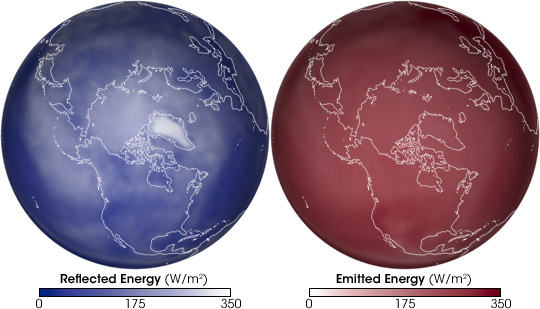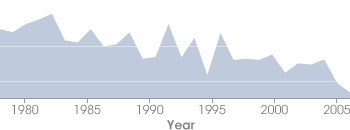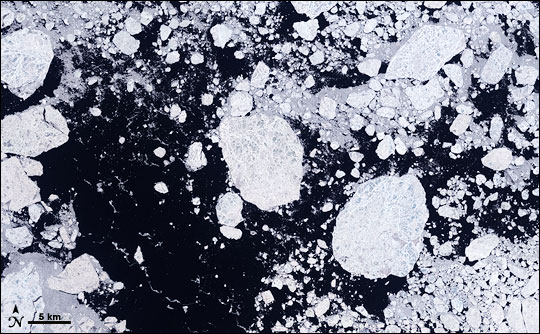

From Plastics to the Poles, A Career Shifts Course | |||
Since he arrived at NASA’s Langley Research Center from graduate school at Penn State in 1998, Kato’s task has been to use NASA satellite data to calculate the radiative flux over the polar regions. It’s not a career he pictured himself in until his early 30s. Born and raised in Japan, Kato studied mechanical engineering as a college student, and ended up in the plastics manufacturing industry. When the company he worked for developed a joint venture company with a U.S. business, it needed someone to relocate to Pennsylvania. Kato volunteered. “When I first came to the U.S., where I was living, between Pittsburgh and Erie,” he says, “was very rural. In the winter, we would get a lot of snow, and there was nothing to do, so I had a lot of time to think. I began to really think about my life, my future. I asked myself, “What can I do with my life, what do I know?’ and I realized I didn’t really know about anything. I thought ‘You know, I’d really like to know something about nature, maybe about global warming.” Kato says it’s good for him that he was living in the United States when this impulse to switch careers hit him. He doesn’t think he would have had the opportunity to go back to school in Japan. “There,” he says, “people don’t think a 30-year-old man should be going back to school. He should be working.” Instead, in the early 1990s, Kato entered the graduate program at the Pennsylvania State University, where one of the meteorology department’s veteran climate researchers, Tom Ackerman, took him under his wing. “That was a big moment in my life. I still remember the feeling—kinda scared—when I walked into his office.” He started taking atmospheric science classes and conducting research into the underlying physics of how light and heat pass into and out of Earth’s atmosphere. |
|||
 | |||
In the late 1990s, he was invited to NASA’s Langley Research Center to give a presentation on the research he had been doing using observations from a Department of Energy project known as ARM, for Atmospheric Radiation Measurements. Soon after, NASA offered him a job working with radiation observations being collected by instruments known as CERES, short for “Clouds and the Earth’s Radiant Energy System.” The sensors measure the shortwave solar radiation the Earth reflects, as well as the longwave radiation the Earth emits. When Kato arrived at Langley in 1998, one CERES instrument was already in space, and two more were planned, one on NASA’s Terra satellite, to be launched in 1999, and one on the Aqua satellite, to be launched in 2002. “When I came to NASA, I was given the task of estimating the energy budget over polar regions—the Arctic and the Antarctic—using CERES data,” says Kato. To get the budget, Kato has to tally up how much of the Sun’s incoming energy the Earth reflects, how much it absorbs, and how much energy it radiates back to space. This energy balance determines the Earth’s temperature “set point.” The first part of the story is figuring out Earth’s albedo, which is the percentage of incoming sunlight the Earth reflects. Earth’s albedo determines how much solar energy actually enters the system and becomes available to heat up the land, the oceans, and the atmosphere. Kato’s interest in the polar regions has focused on what goes on at an altitude that scientists call the “top of the atmosphere,” the nebulous boundary between Earth and space, where the atmosphere becomes thinner, and thinner, and ever-so-gradually, ceases to exist. “There is no such thing as the true ‘top of the atmosphere,’” explains Kato, no one place where you can say “Here the atmosphere ends,” but a ballpark is maybe 100 kilometers above the Earth. It is here that scientists can observe the bottom line of the Earth’s energy budget: how many photons are coming and going. But even though he focuses his attention on the top of the atmosphere, Kato says it has been impossible to ignore all the talk in recent years about what’s been happening on the surface below. Unlike the Antarctic, where the sea ice has retreated and expanded on a less consistent basis, the Arctic has experienced steady declines over the past 20 years or so—for as long as we have been observing it with satellites. In the past few years, Kato says, everyone has been talking about how Arctic sea ice and snow cover are shrinking very rapidly. The talk got him thinking. |
Satellite data show the patterns of reflected shortwave solar energy (blue, left) and longwave thermal energy emitted from the Earth (red, right). The polar perspective of the globes highlights the influence of the Arctic on Earth’s energy balance. Bright surfaces like snow, ice, and clouds reflect the most energy (white), while dark surfaces like open ocean absorb the most (dark blue). Snow, ice, and clouds radiate less energy (light red) than the ocean or snow-free land surfaces (dark red). Seiji Kato and his colleagues used these observations to measure recent changes in the Arctic energy balance. (NASA images by Robert Simmon and Reto Stöckli, based on CERES data.) | ||
 |

Like most scientists, Kato has a hyper-active sense of curiosity. He tries to describe what drives it. “You don’t have to get a Nobel prize or anything,” he says, “but even a tiny, tiny thing…I’m just excited if I am the only one who knows this, for this first time, and nobody else knows. For example, if you go to a different town that you have never visited, and you start walking in the town, and you see a corner…well, I just want to go around that corner and see what’s there. I could do that forever. For this particular study, people were talking about how the Arctic is changing very quickly, how the sea ice is shrinking very rapidly, and I just wanted to know what the atmospheric response is, how the atmosphere is changing with the change of the sea ice. It’s just something that I want to know.” The answer is more important than just a means to satisfy one scientist’s curiosity, however. Almost all climate models predict that the effects of global warming will be most rapid and dramatic in the polar regions. The main reason usually given for this polar amplification is something scientists call the ice albedo feedback. As anyone who has been outside in fresh snow on a sunny day can remember, the surface is blindingly bright. These bright surfaces are like a giant reflector stretched over the poles. But as ice and snow melt, the ocean and land surfaces will emerge like solar panels. When skies are clear, sunlight that would normally have reflected back into space from the bright white surfaces will soak in, which will warm and melt even more ice and snow. The relationship between melting sea ice and the decreasing reflective power of the poles is a positive climate feedback because warming ends up causing more warming. (The reverse is true as well: cooling creates more cooling because more snow and ice reflect more sunlight.) |
Despite changes from year to year, Arctic sea ice (blue shaded area) has been declining for as long as satellites have been observing it. Scientists have long expected that melting of sea ice and snow will make the poles less able to reflect incoming sunlight and will amplify global warming. With dramatic declines of sea ice observed in the early part of the new millennium (2000-2005), Kato began to wonder whether satellites could already observe a change in the Arctic’s reflecting power. (Graph by Robert Simmon, based on data from the National Snow and Ice Data Center.) | |
 |
|||
But, as is usually the case with climate processes, that simple description isn’t the whole story: the positive ice albedo feedback may have a competitor. “If the sea ice shrinks,” says Kato, “intuitively we would think that more water is exposed to the atmosphere, and so more water vapor is available to the atmosphere to form clouds. So in addition to changing sea ice, we can kind of guess that something must be happening in the atmosphere over the Arctic, too.” Clouds are bright, too, and an increase in clouds could cancel out the impact of melting snow and ice on polar albedo. |
Sea ice and snow at the poles are part of a climate ‘merry-go-round’ called the ice-albedo feedback. Increases in sea ice and snow accelerate cooling, while decreases in ice and snow accelerate warming. The reason for this feedback is obvious in this photo-like image of Arctic sea ice captured on June 16, 2001. Dark ocean surfaces absorb incoming sunlight, while sea ice reflects it. As snow and ice melt, the newly exposed dark surfaces absorb more incoming sunlight, further warming the surface. (NASA image by Robert Simmon, based on Landsat-7 data from the Global Land Cover Facility.) | ||